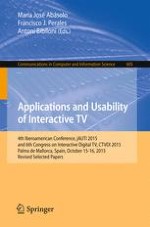2016 | Book
Applications and Usability of Interactive TV
4th Iberoamerican Conference, jAUTI 2015, and 6th Congress on Interactive Digital TV, CTVDI 2015, Palma de Mallorca, Spain, October 15-16, 2015. Revised Selected Papers
Editors: María José Abásolo, Francisco J. Perales, Antoni Bibiloni
Publisher: Springer International Publishing
Book Series : Communications in Computer and Information Science
